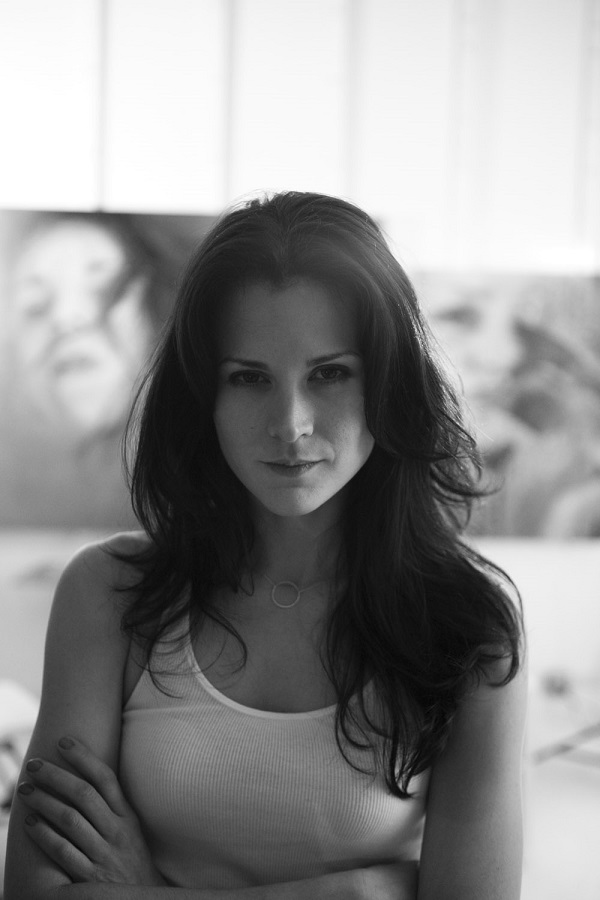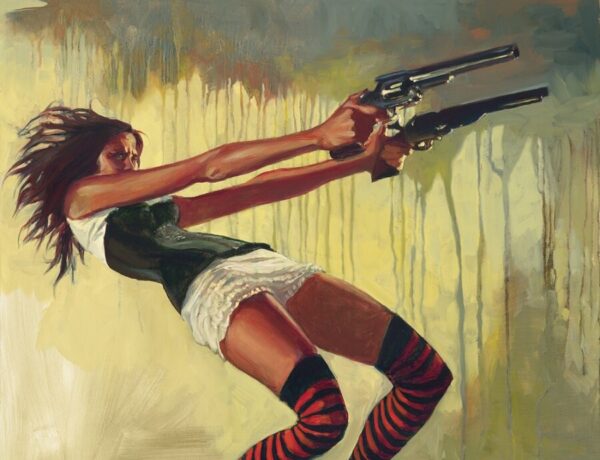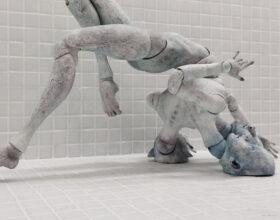New York painter Alyssa Monks has been creating art for over 3 decades. Since a child, she has been experimenting with and perfecting her use of oil paints. Sometimes on panels, sometimes linen, sometimes small-scale but mostly large– works lately depict sun-lit nude figures superimposed with dense, leafy landscapes. Warm tones and seemingly endless open space are thematic to her newer body of work. Greens and oranges create a more pleasant, relaxed atmosphere than previous art series. On the other side of the spectrum, Alyssa Monks’ “Water Series” created between 2005-2014 present tense, steamy, dripping bare figures placed into tight spaces like tubs and showers. They are designed by the artist to make you feel uncomfortable and confused. The dominantly white “water series” paintings further this effect by creating a very aseptic atmosphere.
Thick, goopy oil paint and unapologetic brush marks stem from Monks’ need to always experiment and discover. Her works are very expressive; you can’t help but feel empathy when viewing these portraits. This is typical of all of Alyssa’s art series through out her career. Her drive to connect speaks strongly through her very slow, deliberate paint strokes.
Continue reading for an interview with Alyssa on interpretations of her work, working through loss, and art process of her new art series.
Facebook | Web | Instagram | Twitter
How do you prepare for the layering of landscape over figure [for your “nature series”]? You’ve stated in the past that you photograph references, and I also noticed quite a few charcoal drawings in your portfolio. How are those involved in your process today?
I am building into the process some amount of experimentation and intuition, so avoiding an exact system or procedure is key. I can say that I do take lots of photographs as I have in the past with the water series. Lately I am drawing leaves and vines on my models themselves, and then photographing them. I take pictures of landscapes whenever I am somewhere new or I see something interesting. Sometimes it’s just color notes or combinations that catch my eye. I spend a lot of time pairing the figure with the landscape to collage and overlay them together. I try many combinations, sometimes using 3 or 4 landscapes in one picture. Once I create a photo reference to get me started, I am ready to begin painting loosely based on that reference. However, there is further editing and summarizing of information that happens in the painting process. In translating a photo reference, especially one so complicated but even one that isn’t, I make deliberate choices to leave out details in favor of broader, expressive paint strokes that give more physicality to the surface, and improvise and invent things that aren’t in the reference. So the photos only get me started – much like looking at a live landscape. I can’t paint everything I see, nor would I want to, and I need to make a cohesive and convincing painting. The charcoal drawings are experiments unto themselves. They are not in preparation for the paintings. It’s nice to explore different mediums and ways of working often, it keeps me engaged and curious.

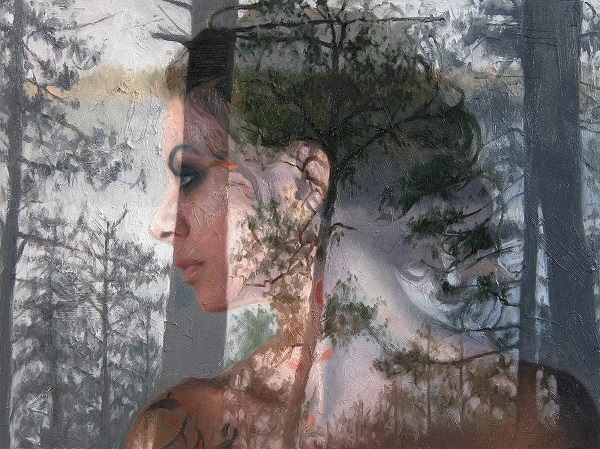
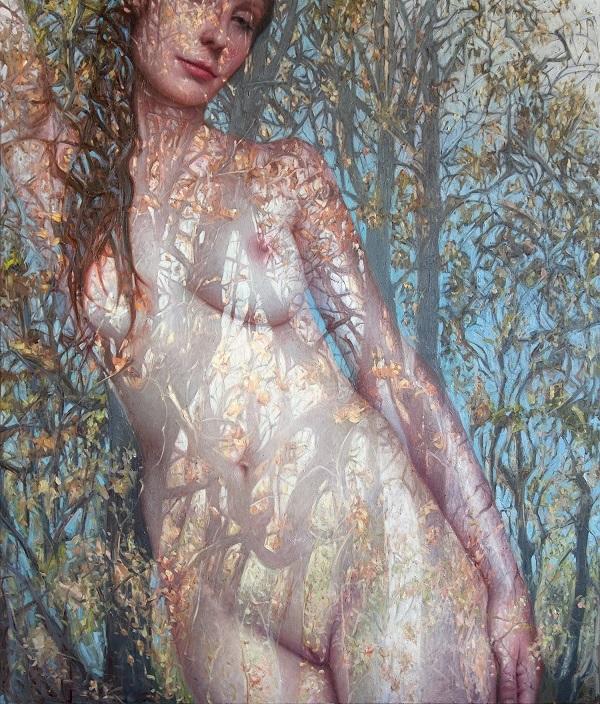
I was very surprised when looking through your previous press to find that at some points your work [Water Series] was described very sexually; going even as far as referring to your paintings as “soft-core porn”…completely in the opposite realm in which I view your work. Does this happen often? If so, how do you view such comments and what is your reaction?
You’re referring to an article in the OC weekly (not an art magazine, more of a light entertainment rag) from 2008 during my water series paintings, and you are not accurately describing it. The article talks about the sensuality of the work, briefly, and more at length how personal and distressed the women are. The writer is actually getting to a larger point of the work, but he is just shy of stating it, seemingly because he is too disturbed by the “creepiness” and “unhappiness” of the women. Here is the quote, in context: “But that eroticism has a creepy dark side. These women do not look happy. Actually, many of them look exhausted and depressed, like they’re scrubbing off the grime after a long, hard day. A few of these images are just straight-up sexy. (Wet, depicting a woman’s shoulders and chin as she bathes, is as close as this show gets to softcore porn.) But some of the women who are seemingly tangled up in shower curtains bear a distressing resemblance to bodies found at a crime scene.” He goes on to say “The paintings take us through various stages of a woman’s life, all of them dripping and nude. Here is a woman, young and supple and full of life (Wet). Here is a woman pregnant and seemingly none too thrilled about it (Vapor). Here is that woman’s freshly born child, covered in sticky glop as it raises its fat little arms and howls to the skies, knowing only its own need (Baptism). And finally, here is Mom, looking back at life and wondering if it was worth all the bother.
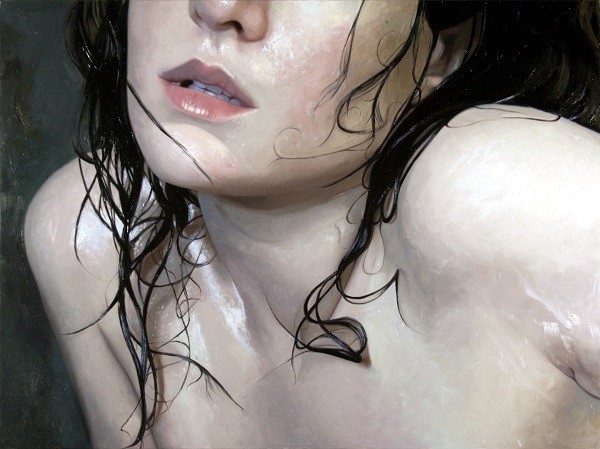
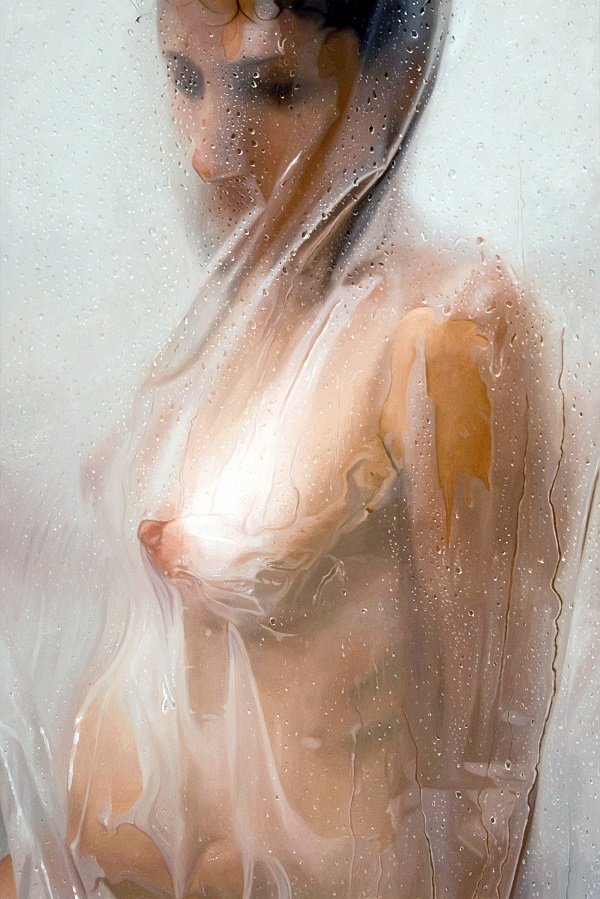
These women feel real, so much so that it can seem wrong to look at them, like . . . well, like you’re peeking in on them while they’re taking a shower. But while the intimacy of these scenes can be creepy, it can also be strangely touching.” So he actually had the correct response to the work, but isn’t aware that his response was the intended one. And yes, that was intentional. The work speaks directly to women who struggle between a need to be a sex object of male desire and a need to be seen and heard and understood and loved. Not everyone is going to understand or read that, it takes some effort to look beyond the superficial and consider an artist’s deeper intention. A better article is Eric Fishl’s essay in my 2009 catalog; he articulated my intention better than I could have myself: “Her paintings express a psychologically charged eroticism. That is a paradox. The language of eroticism is designed to free us from self-consciousness. Self-consciousness undermines fantasy and makes us aware of our own complicated needs and desires. Contradictory impulses, such as our desire to possess and dominate, while at the same time desiring to be dominated and possessed, spark emotions that confuse the moment. In Monks’s work what first appears as a simple exchange of presentation quickly becomes a less than comfortable voyeuristic space charged with emotional ambivalence. These images of women presenting themselves to us from behind scrims of moist vapory glass, translucent vinyl, or submerged beneath soapy bathwater trigger, reflexively a male’s desire while, at the same time, tempering that desire, making us disarmingly aware of a struggle taking place on the other side of the glass. There is a tension created between the viewer and the viewed – her needs vs. my desire.”
My reaction to that comment? There is a lot of press out there. It is not all equal.
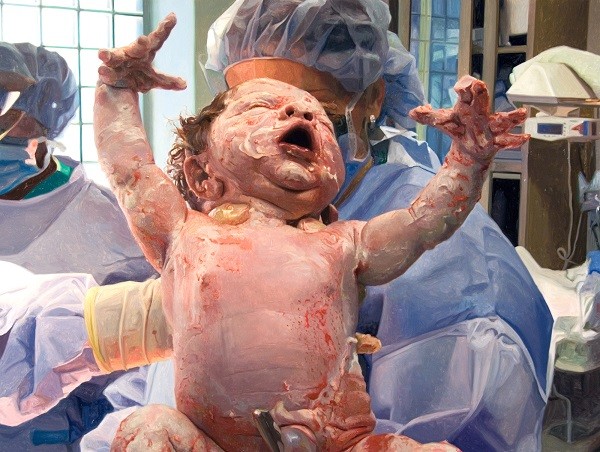

Most art is made as an expression whether done consciously by the artist or not. You focus specifically on expression and connection in your work, and that makes you very aware. Are you able to describe more in depth for our readers how that process of release through creating feels?
It is very important to me to be connected to my tools and materials and my own body while I am actually painting. When I am composing the images, I am in a more cognitive state. But when I am painting, I am trying to connect with the paint itself, through the brush, onto the surface of the canvas. I want to savor those delicious, thick brush strokes as much as possible. It makes for a deliberate surface, and enjoyable one, an “expressive” one as you say. I think of making an expressive painting by making a series of strokes that were slow and conscious. I’m not sure I would describe it as “release”. It feels more like just tuning in, paying attention, slowing down, and savoring the materials and the process. And I can tell in the paint when someone is doing this and when they aren’t. A painter can’t fake that.



Shortly after the passing of your mother, you didn’t want to paint anymore. I can imagine that it made it even harder that you used her frequently as a reference for paintings. Whose face is featured in your current works? What would you say to others that may be going through loss and see no reason to continue their work?
I made 12 portraits of my mother, mostly for my family members, the year after she died. It was a way of grieving and honoring her. I didn’t force myself to paint her. I wanted to. I didn’t want to paint much else because after such a life-changing experience, it was hard to feel that what I was doing was meaningful. The things that motivated me didn’t motivate me anymore. That was difficult to get through. My priorities and values had shifted drastically and I had to create new meaning in my work and my life. One of the things we need to understand about grieving any loss is that it has it’s own timeline and schedule. Any attempt to force it to be different, faster, easier, productive or non-existent will be met with suffering. The kindest way through it is just make space for it and be gentle and compassionate towards it. The more one learns self-care and self-compassion, which is a valuable skill itself, the more tolerable the pain and more resilient one will become.

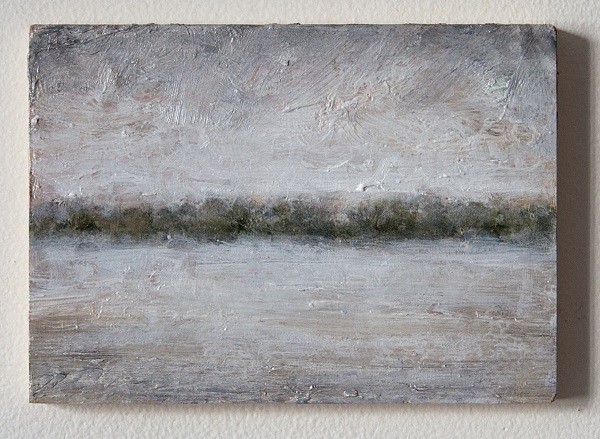
I would recommend meditation and therapy and journaling and if making art or crafts help, then do that, too. I made photo albums, a recipe book, paintings, a talk, videos and wrote a lot. I think creativity is soothing when there is no destination pressuring the outcome. Just do it from a desire to honor and reflect. I don’t think art making in an “art therapy” process is a great idea for a career, to be clear, it is it’s own end, and maybe even should remain private. It can lead to some great work, but purely emotionally expressive art is not the ultimate way to actually express. I think having a little perspective and objectivity from the pain is a more effective place from which to make the work. I tap into the emotions, but I use my objectivity to navigate the process and evaluate it’s effectiveness and impact. Raw emotion tends to be un-relatable. Like a child crying and screaming with discomfort and pain – once there is language that can articulate what the feeling is, there is empathy and understanding. Just the screaming isn’t going to be appreciated fully without context and language. The objectivity gives an artist some ability to create a language to use to express the experience. I recommend listening to David Lynch’s “Catching the Big Fish”.
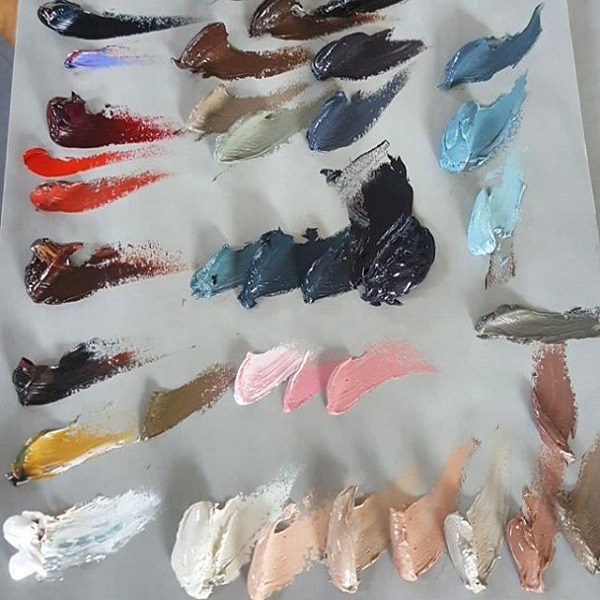

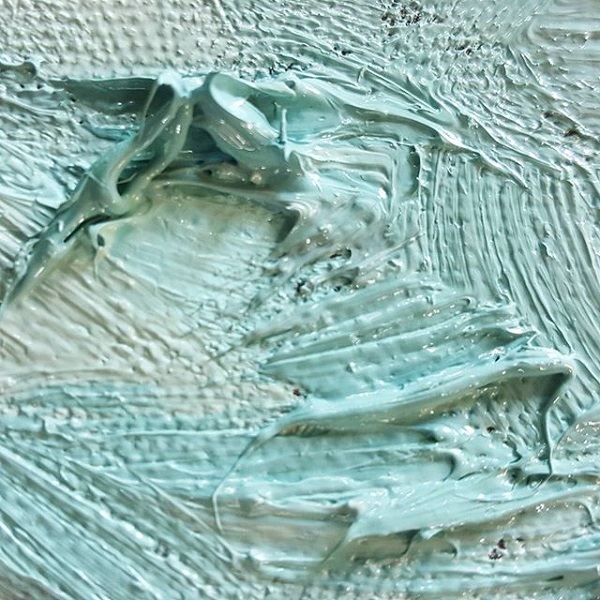
While your looking out a window, or going for a walk, what catches your eye in a landscape that really makes you have to paint it?
I’m attracted to complexity of texture and color. I like when something looks abstract out of context, surprising, unreal, and unpredictable. That’s what draws me to want to explore it and paint it. There is a sweet spot of chaos and repetition that triggers my attraction. I’m always looking for it. I like when things are kind of difficult to decipher. That draws me in and makes me pay a little more attention.

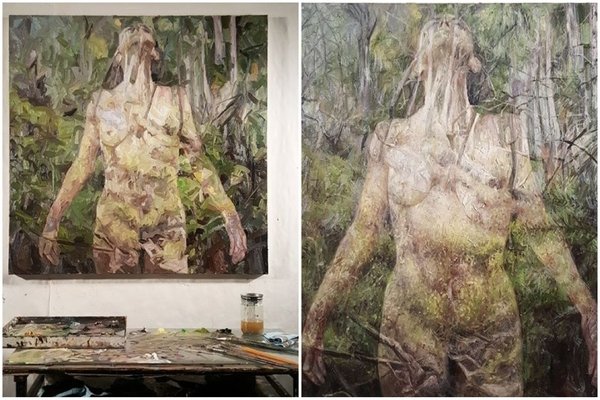
Your 2016 portfolios includes a new shower piece thematic to your earlier series. In the future do you think you’ll go back to that body of work, or what do you think your future holds instead?
I am presently working with the landscape filters and plan to do that for a few years at least. One thing always leads to the next. I don’t see myself revisiting the water series in the same ways I painted water before. I enjoy the evolution and curiosity that leads me from one subject to another, one perspective to another. It feels like an adventure and I don’t know where it will go next. That is exciting to me. I don’t expect all my experiments to be popular, but for me, painting is about experimentation and curiosity. If I stand still or revert I am not feeling very curious. I know one idea will lead me to the next so I make space for that flow.
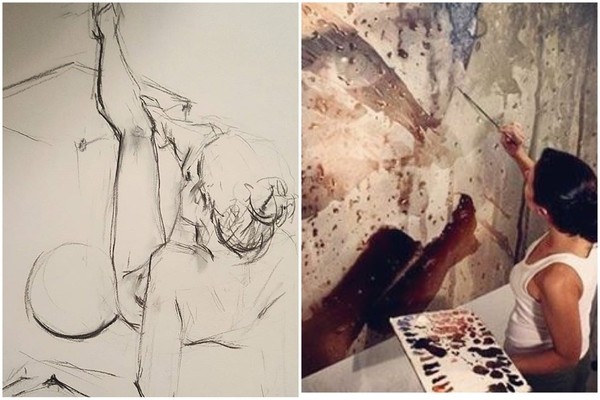

Painter Alyssa Monks finds beauty and inspiration in the unknown, the unpredictable and even the awful.
In a poetic, intimate talk, she describes the interaction of life, paint and canvas through her development as an artist, and as a human, in the TED talk below.


